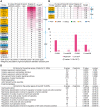Kinase impact assessment in the landscape of fusion genes that retain kinase domains: a pan-cancer study
- PMID: 28013235
- PMCID: PMC5952959
- DOI: 10.1093/bib/bbw127
Kinase impact assessment in the landscape of fusion genes that retain kinase domains: a pan-cancer study
Abstract
Assessing the impact of kinase in gene fusion is essential for both identifying driver fusion genes (FGs) and developing molecular targeted therapies. Kinase domain retention is a crucial factor in kinase fusion genes (KFGs), but such a systematic investigation has not been done yet. To this end, we analyzed kinase domain retention (KDR) status in chimeric protein sequences of 914 KFGs covering 312 kinases across 13 major cancer types. Based on 171 kinase domain-retained KFGs including 101 kinases, we studied their recurrence, kinase groups, fusion partners, exon-based expression depth, short DNA motifs around the break points and networks. Our results, such as more KDR than 5'-kinase fusion genes, combinatorial effects between 3'-KDR kinases and their 5'-partners and a signal transduction-specific DNA sequence motif in the break point intronic sequences, supported positive selection on 3'-kinase fusion genes in cancer. We introduced a degree-of-frequency (DoF) score to measure the possible number of KFGs of a kinase. Interestingly, kinases with high DoF scores tended to undergo strong gene expression alteration at the break points. Furthermore, our KDR gene fusion network analysis revealed six of the seven kinases with the highest DoF scores (ALK, BRAF, MET, NTRK1, NTRK3 and RET) were all observed in thyroid carcinoma. Finally, we summarized common features of 'effective' (highly recurrent) kinases in gene fusions such as expression alteration at break point, redundant usage in multiple cancer types and 3'-location tendency. Collectively, our findings are useful for prioritizing driver kinases and FGs and provided insights into KFGs' clinical implications.
Figures






Similar articles
-
ROS1 fusions in cancer: a review.Future Oncol. 2016 Aug;12(16):1911-28. doi: 10.2217/fon-2016-0050. Epub 2016 Jun 3. Future Oncol. 2016. PMID: 27256160 Review.
-
ALK, ROS1 and RET fusions in 1139 lung adenocarcinomas: a comprehensive study of common and fusion pattern-specific clinicopathologic, histologic and cytologic features.Lung Cancer. 2014 May;84(2):121-6. doi: 10.1016/j.lungcan.2014.02.007. Epub 2014 Feb 19. Lung Cancer. 2014. PMID: 24629636
-
Identification of Driving ALK Fusion Genes and Genomic Landscape of Medullary Thyroid Cancer.PLoS Genet. 2015 Aug 21;11(8):e1005467. doi: 10.1371/journal.pgen.1005467. eCollection 2015 Aug. PLoS Genet. 2015. PMID: 26295973 Free PMC article.
-
Kinase domain activation through gene rearrangement in multiple myeloma.Leukemia. 2018 Nov;32(11):2435-2444. doi: 10.1038/s41375-018-0108-y. Epub 2018 Mar 23. Leukemia. 2018. PMID: 29654269 Free PMC article.
-
The rationale for druggability of CCDC6-tyrosine kinase fusions in lung cancer.Mol Cancer. 2018 Feb 19;17(1):46. doi: 10.1186/s12943-018-0799-8. Mol Cancer. 2018. PMID: 29455670 Free PMC article. Review.
Cited by
-
MET-dependent solid tumours - molecular diagnosis and targeted therapy.Nat Rev Clin Oncol. 2020 Sep;17(9):569-587. doi: 10.1038/s41571-020-0377-z. Epub 2020 Jun 8. Nat Rev Clin Oncol. 2020. PMID: 32514147 Free PMC article. Review.
-
[Drug Resistance Mechanism and Therapeutic Strategy of Targeted Therapy of Non-small Cell Lung Cancer with MET Alterations].Zhongguo Fei Ai Za Zhi. 2023 Sep 20;26(9):684-691. doi: 10.3779/j.issn.1009-3419.2023.102.33. Zhongguo Fei Ai Za Zhi. 2023. PMID: 37985154 Free PMC article. Chinese.
-
Decoding Oncofusions: Unveiling Mechanisms, Clinical Impact, and Prospects for Personalized Cancer Therapies.Cancers (Basel). 2023 Jul 19;15(14):3678. doi: 10.3390/cancers15143678. Cancers (Basel). 2023. PMID: 37509339 Free PMC article. Review.
-
Mining potentially actionable kinase gene fusions in cancer cell lines with the KuNG FU database.Sci Data. 2020 Nov 30;7(1):420. doi: 10.1038/s41597-020-00761-2. Sci Data. 2020. PMID: 33257674 Free PMC article.
-
Genomically Complex Human Angiosarcoma and Canine Hemangiosarcoma Establish Convergent Angiogenic Transcriptional Programs Driven by Novel Gene Fusions.Mol Cancer Res. 2021 May;19(5):847-861. doi: 10.1158/1541-7786.MCR-20-0937. Epub 2021 Mar 1. Mol Cancer Res. 2021. PMID: 33649193 Free PMC article.
References
Publication types
MeSH terms
Substances
Grants and funding
LinkOut - more resources
Full Text Sources
Other Literature Sources
Research Materials
Miscellaneous

